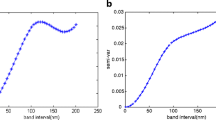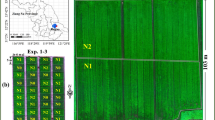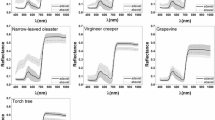Abstract
An effective technique to measure foliage chlorophyll concentration (Chl) at a large scale and within a short time could be a powerful tool to determine fertilization amount for crop management. The objective of this study was to investigate the inversion of foliage Chl vertical-layer distribution by bi-directional reflectance difference function (BRDF) data, so as to provide a theoretical basis for monitoring the growth and development of winter wheat and for providing guidance on the application of fertilizer. Remote sensing could provide a powerful tool for large-area estimation of Chl. Because of the vertical distribution of leaves in a wheat stem, Chl vertical distribution characteristics show an obvious decreasing trend from the top of the canopy to the ground surface. The ratio of transformed chlorophyll absorption reflectance index (TCARI) to optimized soil adjusted vegetation index (OSAVI) was called the canopy chlorophyll inversion index (CCII) in this study. The value of CCII at nadir, ±20 and ±30°, at nadir, ±30 and ±40°, and at nadir, ±50 and ±60° view angles were selected and assembled as bottom-layer Chl inversion index (BLCI), middle-layer Chl inversion index (MLCI), and upper-layer Chl inversion index (ULCI), respectively, for the inversion of Chl at the vertical bottom layer, middle layer, and upper layer. The root mean squared error (RMSE) between BLCI-, MLCI-, and ULCI-derived and laboratory-measured Chl were 0.7841, 0.9426, and 1.7398, respectively. The vertical foliage Chl inversion could be used to monitor the crop growth status and to guide fertilizer and irrigation management. The results suggested that vegetation indices derived from bi-directional reflectance spectra (e.g., BLCI, ULCI, and MLCI) were satisfactory for inversion of the Chl vertical distribution.






Similar content being viewed by others
Abbreviations
- Chl:
-
Chlorophyll concentration
- BRDF:
-
Bi-directional reflectance difference function
- TCARI:
-
Transformed chlorophyll absorption reflectance index
- CARI:
-
Chlorophyll absorption in reflectance index
- OSAVI:
-
Optimized soil adjusted vegetation index
- CCII:
-
TCARI/OSAVI
- BLCI:
-
Bottom-layer Chl inversion index
- MLCI:
-
Middle-layer Chl inversion index
- ULCI:
-
Upper-layer Chl inversion index
- RMSE:
-
The root mean squared error
- LOV:
-
Leaf orientation value
- LAD:
-
Leaf angle distribution
- VZA:
-
View zenith angles
References
Adamsen, F. J., Pinter, P. J., Barnes, E. M., LaMorte, R. L., Wall, G. W., Leavitt, S. W., et al. (1999). Measuring wheat senescence with a digital camera. Crop Science, 39, 719–724.
Anten, N. P. R., Schieving, F., & Werger, M. J. A. (1995). Patterns of light and nitrogen distribution in relation to whole canopy carbon gain in C3 and C4 mono-and dicotyledonous species. Oecologia, 101, 504–513.
Arnon, D. I. (1949). Copper enzymes in isolated chloroplasts Polyphenoloxidae in Beta vulgaris. Plant Physiology, 24, 1–15.
Campbell, R. J., Mobley, K. N., Marini, R. P., & Pfeiffer, D. G. (1990). Growing conditions influence mite damage on apple and peach leaves. Horticultural Science, 25, 445–448.
Connor, D. J., Sadras, V. O., & Hall, A. J. (1995). Canopy N distribution and the photosynthetic performance of sunflower crops during grain filling—a quantitative analysis. Oecologia, 101, 274–281.
Curran, P. J., Dungan, J. L., Macler, B. A., & Plummer, S. E. (1991). The effect of a red edge pigment on the relationship between red-edge and chlorophyll concentration. Remote Sensing of Environment, 35, 69–75.
Daughtry, C. S. T., Walthall, C. L., Kim, M. S., Brown, E., & Mcmurtrey, J. E. (2000). Estimating corn leaf chlorophyll content from leaf and canopy reflectance. Remote Sensing of Environment, 74(2), 229–239.
Demarez, V., & Gastellu-Etchegorry, J. P. (2000). A modeling approach for studying forest chlorophyll content. Remote Sensing of Environment, 71, 226–238.
Filella, I., Serrano, L., Serra, J., & Penuelas, J. (1995). Evaluating wheat nitrogen status with canopy reflectance indices and discriminant analysis. Crop Science, 35, 1400–1405.
Haboudane, D., Miller, J., & Tremblay, N. (2002). Integrated narrow-band vegetation indices for prediction of crop chlorophyll concentration for application to precision agriculture. Remote Sensing of Environment, 81, 416–426.
Hikosaka, K., Terashima, I., & Katoh, S. (1994). Effects of leaf age, nitrogen nutrition and photo flux density on the distribution of nitrogen among leaves of a vine (Ipomoea tricolor Cav.) grown horizontally to avoid mutual shading of leaves. Oecologia, 97, 451–457.
Huang, W. J., Niu, Z., Wang, J. H., Liu, L. Y., Zhao, C. J., & Liu, Q. (2006). Identifying crop leaf angle distribution based on two- temporal and bidirectional canopy reflectance. IEEE Transactions on Geoscience and Remote Sensing, 44(12), 3601–3609.
Huang, W. J., Wang, J. H., Liu, L. Y., Zhao, C. J., Wang, Z. J., & Wang, J. D. (2004a). Inversion of biochemical parameters by selection of proper vegetation index in winter wheat. Agricultural Sciences in China, 33, 178–185.
Huang, W. J., Wang, J. H., Wang, Z. J., Zhao, C. J., Liu, L. Y., & Wang, J. D. (2004b). Inversion of foliar biochemical parameters at various physiological stages and grain quality indicators of winter wheat with canopy reflectance. International Journal of Remote Sensing, 25(12), 2409–2419.
Huete, A. R. (1988). A soil-adjusted vegetation index (SAVI). Remote Sensing of Environment, 25, 295–309.
Kim, M. S., Daughtry, C. S. T., Chappelle, E. W., Mcmurtrey III, J. E. (1994). The use of high spectral resolution bands for estimating absorbed photosynthetically active radiation. In Proceedings of the sixth symposium on physical measurements and signatures in remote sensing, Val D’Isere, France, pp. 299–306, January 17–21.
Lemaire, G., Onillon, B., Gosse, G., et al. (1991). Nitrogen distribution with in a lucerne canopy during regrowth, relation with light distribution. Annals of Botany, 68, 483–488.
Massart, D. L., Vandeginste, B. G. M., Deming, S. M., Michotte, Y., & Kaufman, L. (1988). Chemometrics: A textbook, data handling in science and technology (Vol. 2, pp. 41–48). NewYork: Elsevier.
Miller, J. R., Wu, J., Boyer, M. G., Belanger, M., & Hare, E. W. (1991). Seasonal patterns in leaf reflectance red-edge characteristics. International Journal of Remote Sensing, 12, 1509–1523.
Pearcy, R. W., & Seemann, J. R. (1990). Photosynthetic induction state of leaves in a soybean canopy in relation to light regulation of ribulose-1–5-bisphosphate carboxylase and stomatal conductance. Plant Physiology, 94(2), 628–633.
Pepper, G. E., Pearce, R. B., & Mock, J. J. (1977). Leaf orientation distribution and yield of maize. Crop Science, 17, 883–886.
Poorter, L., Oberbauer, S. F., & Clark, D. B. (1995). Leaf optical properties along a vertical gradient in a tropical rain forest canopy in Costa Rica. Botanical Society of America, 82(10), 1257–1263.
Rondeaux, G., Steven, M., & Baret, F. (1996). Optimization of soil-adjusted vegetation indices. Remote Sensing of Environment, 55, 95–101.
Shadchina, T. M., Dmitrieva, V. V., & Morgoun, V. V. (1998). Inter-relation between nitrogen status of the plants, leaf chlorophyll and grain yield in various winter wheat cultivars. Acta Agronomica Hungarica, 46, 25–34.
Shiraiwa, T., & Sinclair, T. R. (1993). Distribution of N among leaves in soybean canopies. Crop Science, 33, 804–808.
Sims, D. A., & Gamon, J. A. (2002). Relationships between leaf pigment content and spectral reflectance across a wide range of species, leaf structures and developmental stages. Remote Sensing of Environment, 81, 337–354.
Thomas, J. R., & Gausman, H. W. (1977). Leaf reflectance versus leaf chlorophyll and carotenoid concentrations for eight crops. Agronomy Journal, 69, 799–802.
Thomas, H., Nicholas, C. C., Samuel, B. C., Michael, A. W., Mathew, B., Andrew, B., et al. (2009). Detection of foliage conditions and disturbance from multi-angular high spectral resolution remote sensing. Remote Sensing of Environment, 113, 421–434.
Thomas, J. R., & Oerther, G. F. (1972). Estimating nitrogen concentration of sweet pepper leaves by reflectance measurements. Agronomy Journal, 64, 11–13.
Vouillot, M. O., & Devienne-Barret, F. (1999). Accumulation and remobilization of nitrogen in a vegetative winter wheat crop during or following nitrogen deficiency. Annals of Botany, 3, 569–575.
Wang, Z. J., Wang, J. H., Liu, L. Y., & Huang, W. J. (2004). Prediction of grain protein content in winter wheat (Triticum aestivum L.) using plant pigment ratio (PPR). Field Crops Research, 90(2&3), 11–321.
Wang, Z. J., Wang, J. H., Liu, L. Y., Huang, W. J., Zhao, C. J., & Lu, Y. L. (2005a). Estimation of nitrogen deficiency at middle and bottom layers of winter wheat canopy by using ground measured canopy reflectance. Communications in Soil Science and Plant Analysis, 36(17&18), 2289–2300.
Wang, J. H., Wang, Z. J., Uchida, S., & Huang, W. J. (2009). Relative discrimination of planophile and erectophile wheat types using multi-temporal spectrum measurements. Japan Agricultural Research Quarterly, 43(2), 157–166.
Wang, Z. J., Wang, J. H., Zhao, C. J., Zhao, M., Huang, W. J., & Wang, C. Z. (2005b). Vertical distribution of nitrogen in different layers of leaf and stem and their relationship with grain quality of winter wheat. Journal of Plant Nutrition, 28(1), 73–91.
Zadoks, J. C., Chang, T. T., & Konzak, C. F. (1974). A decimal code for the growth stages of cereals. Weed Research, 14, 415–421.
Zarco-Tejada, P. J., Miller, J. R., Noland, T. L., Mohammed, G. H., & Sampson, P. H. (2001). Scaling-up and model inversion methods with narrow-band optical indices for chlorophyll content estimation in closed forest canopies with hyperspectral data. IEEE Transactions on Geoscience and Remote Sensing, 39, 1491–1507.
Zhao, C. J., Jiang, A. N., Huang, W. J., Liu, K. L., Liu, L. Y., & Wang, J. H. (2007). Evaluation of variable-rate nitrogen recommendation of winter wheat based on SPAD measurement. New Zealand Journal of Agricultural Research, 50, 735–741.
Acknowledgments
This work was subsidized by the National High Tech R&D Program of China (2006AA10A302, 2006AA10Z203, 2008AA10Z214), National Natural Science Foundation of China (40701119, 40701120), and Special Funds for Major State Basic Research Project (2007CB714406, 2005CB121103). The authors are grateful to Mr. Weiguo Li, and Mrs. Hong Chang for data collection. We also thank Dr. Benjiamin Li for his editing and improving of the paper.
Author information
Authors and Affiliations
Corresponding author
Additional information
Wenjiang Huang is an associate professor of application of quantitative remote sensing in agriculture.
Rights and permissions
About this article
Cite this article
Huang, W., Wang, Z., Huang, L. et al. Estimation of vertical distribution of chlorophyll concentration by bi-directional canopy reflectance spectra in winter wheat. Precision Agric 12, 165–178 (2011). https://doi.org/10.1007/s11119-010-9166-5
Published:
Issue Date:
DOI: https://doi.org/10.1007/s11119-010-9166-5




